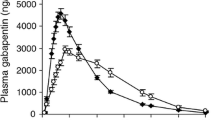Abstract
10 years after the first registration of an oxcarbazepine product, the “old” Trileptal® formulation, in Denmark in 1990, a European registration procedure was performed with another OXC formulation (“new” Trileptal®), which differed slightly from the first product in its pharmacokinetic properties. The new formulation showed higher Cmax values and it was absorbed faster (shorter tmax values). In patients requiring higher dosages we observed more often neurotoxic adverse effects (e.g. dizziness, drowsiness, ataxia etc.) shortly after oral intake thus limiting the possibility to further increase the dosage. Another OXC formulation, which is within the enlarged ranges bioequivalent to the old Trileptal®, is still marketed as Apydan® in Finland, Denmark and some other European countries. This formulation possesses even lower Cmax values and slower increase of MHD plasma concentration. We replaced Trileptal®/Timox® in 10 patients with neurotoxic symptoms by the identical dosage of Apydan® hypothesising that the tolerability would improve. Seven of ten patients tolerated Apydan® without side effects and have therefore continued with that OXC formulation. Further dosage increases were possible in four cases. Three of these and one further patient whose dosage was not elevated reported subsequently a seizure reduction by more than 50%. Our data suggest that in the higher dosage range an OXC formulation with a less steep increase of the plasma peak may be advantageous. A slow-release OXC formulation most probably will further improve the therapeutic possibilities with OXC substantially.
Zusammenfassung
Nachdem 1990 in Dänemark erstmalig ein Oxcarbazepin (OXC) Produkt („altes“ Trileptal®) zugelassen worden war, folgte knapp 10 Jahre später im Rahmen eines europäischen Zulassungsverfahrens in zahlreichen europäischen Ländern die Zulassung einer weiteren OXC-Formulierung mit etwas anderen pharmakokinetischen Eigenschaften („neues“ Trileptal®, in Deutschland als identisches Produkt auch als Timox® erhältlich). Diese neue OXC-Formulierung unterscheidet sich vor allem durch höhere Cmax-Werte sowie eine etwas schnellere Resorption (kürzeres tmax) vom „alten“ Trileptal ®. Im höheren Dosisbereich beobachten wir seither unter dem „neuen Trileptal®“ häufiger, dass neurotoxische Störwirkungen (wie z. B. Schwindel, Benommenheit, Ataxie etc.) kurz nach Einnahme auftreten und die weitere Aufdosierung limitieren. Eine weitere, zur „alten“ Trileptal® Formulierung innerhalb der erweiterten Grenzen bioäquivalente Darreichungsform (Apydan®) wird heute noch in Finnland, Dänemark und einigen anderen europäischen Ländern vertrieben. Diese Formulierung weist noch geringere Cmax-Werte sowie einen langsameren Anstieg der Plasmakonzentration von Monohydroxidderivat (MHD), dem wirksa men Metaboliten von OXC auf. Bei 10 Patienten, in deren Fall unter OXC neurotoxische Störwirkungen auftraten, ersetzten wir – unter der Hypothese einer besseren Verträglichkeit – Trileptal®/ Timox® durch Apydan® in identischer Dosis. Sieben von zehn Patienten tolerierten dies störwirkungsfrei und werden daher nun mit Apydan® weiterbehandelt. Weitere Dosiserhöhungen, um eine bessere Anfallskontrolle zu erzielen, waren in vier Fällen möglich. Bei drei dieser Patienten sowie einem weiteren, bei dem keine Dosisanhebung veranlasst wurde, konnten eine Abnahme der Anfallsfrequenz um > 50% erreicht werden. Unsere Daten sprechend dafür, dass zumindest im höheren Dosisbereich ein OXCPräparat mit weniger steilem Anstieg der Wirkstoffkonzentration im Plasma und geringeren Spitzenspiegelwerten des wirksamen Metaboliten von OXC, dem MHD, wünschenswert wäre. Ein retardiertes OXC könnte die Möglichkeiten der Behandlung mit dieser Substanz wohl nochmals entscheidend verbessern.
Similar content being viewed by others
References
Christe W, Krämer G, Vigonius U, Pohlmann H, Steinhoff BJ, Brodie MJ, Moore A, the International Oxcarbazepine/ Valproate Trial Group (1997) A double-blind controlled clinical trial of oxcarbazepine versus sodium valproate in adults with newly diagnosed epilepsy. Epilepsy Res 26:451–460
Dam M, Ekberg R, Loyning Y, Waltimo O, Jakobsen K (1989) A double-blind study comparing oxcarbazepine and carbamazepine in patients with newly diagnosed, previously untreated epilepsy. Epilepsy Res 3:70–76
Guerreiro MM, Vigonius U, Pohlmann H, de Manreza ML, Fejerman N, Antoniuk SA, Moore A (1997) A doubleblind controlled, clinical trial of oxcarbazepine versus phenytoin in children and adolescents with epilepsy. Epilepsy Res 27:205–213
Flesch G, Tudor D, Souppart C, D’Souza J, Hossain M (2002) Oxcarbazepine final market image tablet formulation bioequivalence study after single administration and at steady state in healthy subjects. Int J Clin Pharmacol Ther 40:524–532
May TW, Korn-Merker E, Rambeck B (2003) Clinical pharmacokinetics of oxcarbazepine. Clin Pharmacokinet 42:1023–1042
Reinikainen J, Keränen T, Halonen T, Komulainen H, Riekkinen PJ (1987) Comparison of oxcarbazepine and carbamazepine: a double-blind study. Epilepsy Res 1:284–289
Retzow A, Wangemann M (1998) Biopharmaceutical properties of a new oxcarbazepine- containing drug preparation. 10th World Congress Tuberous Sclerosis, Göteborg, p 13
Wellington K, Goa KL (2001) Oxcarbazepine: an update of its efficacy in the management of epilepsy. CNS Drugs 15:137–163
Fachinformation Timox®/Trileptal® (Stand November 2005)
Author information
Authors and Affiliations
Corresponding author
Rights and permissions
About this article
Cite this article
Steinhoff, B.J. Unterschiede in den biopharmazeutischen Eigenschaften von Oxcarbazepinpräparaten können die Verträglichkeit insbesondere bei höheren Tagesdosen relevant beeinflussen. Z. Epileptol. 20, 76–80 (2007). https://doi.org/10.1007/s10309-007-0251-3
Received:
Accepted:
Issue Date:
DOI: https://doi.org/10.1007/s10309-007-0251-3




